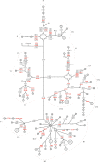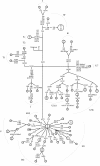Mitochondrial DNA variant m.15218A > G in Finnish epilepsy patients who have maternal relatives with epilepsy, sensorineural hearing impairment or diabetes mellitus
- PMID: 23870133
- PMCID: PMC3726289
- DOI: 10.1186/1471-2350-14-73
Mitochondrial DNA variant m.15218A > G in Finnish epilepsy patients who have maternal relatives with epilepsy, sensorineural hearing impairment or diabetes mellitus
Abstract
Background: Mitochondrial diseases caused by mutations in mitochondrial DNA (mtDNA) affect tissues with high energy demand. Epilepsy is one of the manifestations of mitochondrial dysfunction when the brain is affected. We have studied here 79 Finnish patients with epilepsy and who have maternal first- or second-degree relatives with epilepsy, sensorineural hearing impairment or diabetes mellitus.
Methods: The entire mtDNA was studied by using conformation sensitive gel electrophoresis and PCR fragments that differed in mobility were directly sequenced.
Results: We found a common nonsynonymous variant m.15218A > G (p.T158A, MTCYB) that occurs in haplogroup U5a1 to be more frequent in patients with epilepsy. The m.15218A > G variant was present in five patients with epilepsy and in four out of 403 population controls (p = 0.0077). This variant was present in two branches in the phylogenetic network constructed on the basis of mtDNA variation among the patients. Three algorithms predicted that m.15218A > G is damaging in effect.
Conclusions: We suggest that the m.15218A > G variant is mildly deleterious and that mtDNA involvement should be considered in patients with epilepsy and who have a maternal history of epilepsy, sensorineural hearing impairment or diabetes mellitus.
Figures




Similar articles
-
Mitochondrial DNA sequence variation in Finnish patients with matrilineal diabetes mellitus.BMC Res Notes. 2012 Jul 10;5:350. doi: 10.1186/1756-0500-5-350. BMC Res Notes. 2012. PMID: 22780954 Free PMC article.
-
Prevalence and clinical features of the mitochondrial m.1555A>G mutation in Taiwanese patients with idiopathic sensorineural hearing loss and association of haplogroup F with low penetrance in three families.Ear Hear. 2007 Jun;28(3):332-42. doi: 10.1097/AUD.0b013e318047941e. Ear Hear. 2007. PMID: 17485982
-
Increased variation in mtDNA in patients with familial sensorineural hearing impairment.Hum Genet. 2003 Aug;113(3):220-7. doi: 10.1007/s00439-003-0966-9. Epub 2003 Jun 12. Hum Genet. 2003. PMID: 12802679
-
Mitochondrial non-syndromic sensorineural hearing loss: a clinical, audiological and pathological study from Italy, and revision of the literature.Biosci Rep. 2008 Feb;28(1):49-59. doi: 10.1042/BSR20070027. Biosci Rep. 2008. PMID: 18215147 Review.
-
The spectrum of clinical presentation, diagnosis, and management of mitochondrial forms of diabetes.Pediatr Diabetes. 2015 Feb;16(1):1-9. doi: 10.1111/pedi.12223. Epub 2014 Oct 20. Pediatr Diabetes. 2015. PMID: 25330715 Review.
Cited by
-
Identification and analysis of mtDNA genomes attributed to Finns reveal long-stagnant demographic trends obscured in the total diversity.Sci Rep. 2017 Jul 21;7(1):6193. doi: 10.1038/s41598-017-05673-7. Sci Rep. 2017. PMID: 28733587 Free PMC article.
-
Mitochondrial DNA variants and their impact on epigenetic and biological aging in young adulthood.Transl Psychiatry. 2025 Jan 22;15(1):16. doi: 10.1038/s41398-025-03235-4. Transl Psychiatry. 2025. PMID: 39837837 Free PMC article.
-
Contribution of mitochondrial gene variants in diabetes and diabetic kidney disease.Front Endocrinol (Lausanne). 2022 Oct 12;13:953631. doi: 10.3389/fendo.2022.953631. eCollection 2022. Front Endocrinol (Lausanne). 2022. PMID: 36313763 Free PMC article.
-
Targeted Sequencing of the Mitochondrial Genome of Women at High Risk of Breast Cancer without Detectable Mutations in BRCA1/2.PLoS One. 2015 Sep 25;10(9):e0136192. doi: 10.1371/journal.pone.0136192. eCollection 2015. PLoS One. 2015. PMID: 26406445 Free PMC article. Clinical Trial.
-
Mitochondria and oxidative stress in epilepsy: advances in antioxidant therapy.Front Pharmacol. 2025 Mar 19;15:1505867. doi: 10.3389/fphar.2024.1505867. eCollection 2024. Front Pharmacol. 2025. PMID: 40177125 Free PMC article. Review.
References
-
- Turnbull J, Lohi H, Kearney JA, Rouleau GA, Delgado-Escueta AV, Meisler MH, Cossette P, Minassian BA. Sacred disease secrets revealed: the genetics of human epilepsy. Hum Mol Genet. 2005;14 Spec No. 2:2491–2500. - PubMed
-
- Federico A, Cardaioli E, Da Pozzo P, Formichi P, Gallus GN, Radi E. Mitochondria, oxidative stress and neurodegeneration. J Neurol Sci. 2012;322(1–2):254–262. - PubMed
Publication types
MeSH terms
Substances
LinkOut - more resources
Full Text Sources
Other Literature Sources
Medical

